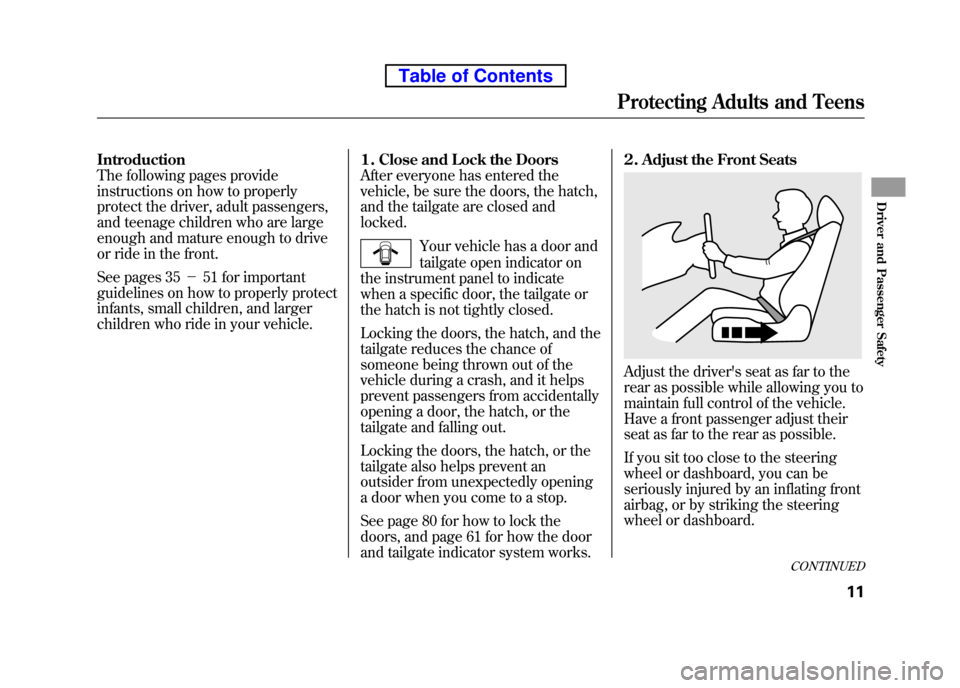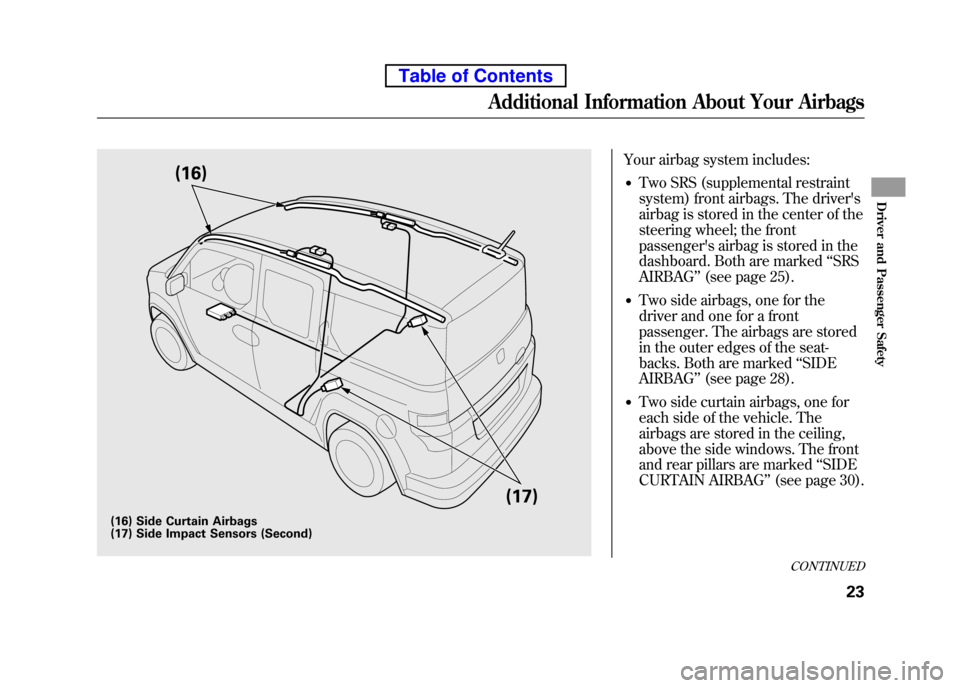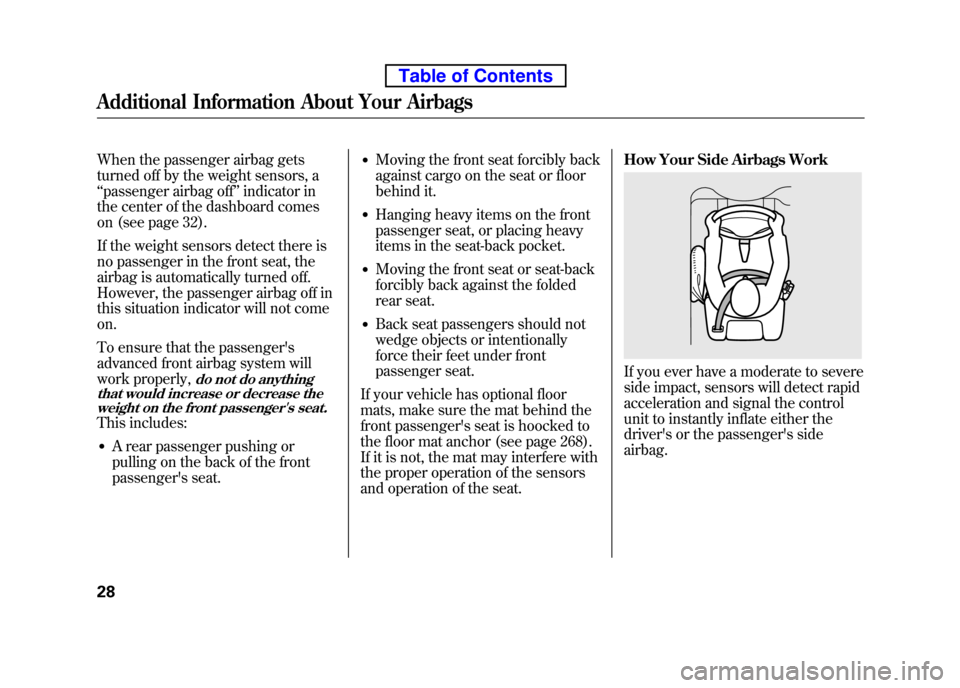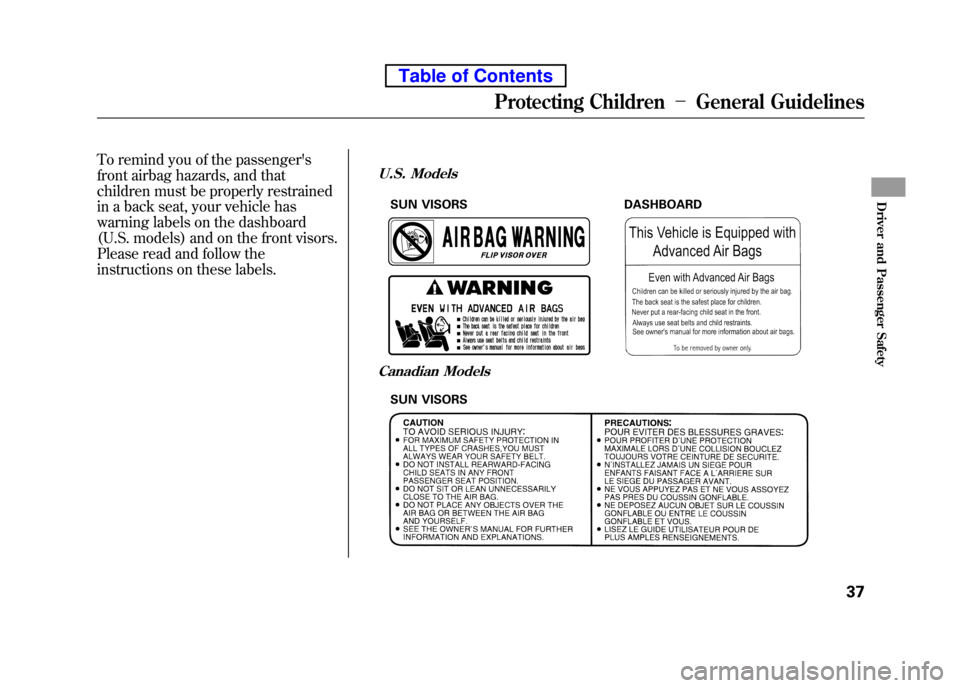dashboard HONDA ELEMENT 2010 1.G Owners Manual
[x] Cancel search | Manufacturer: HONDA, Model Year: 2010, Model line: ELEMENT, Model: HONDA ELEMENT 2010 1.GPages: 342, PDF Size: 5.76 MB
Page 3 of 342

Cup Holders................................. 99
Customer Service .......................322
D
DANGER, Explanation of .............iii
Dashboard ............................... 3, 56
Daytime Running Lights ..............72
Daytime Running Lights
Indicator ................................... 60
Dead Battery .............................. 291
Defects, Reporting Safety (U.S. only) ....................................... 324
Defogger, Rear Window ...............74
Dimensions ................................ 308
Dimming the Headlights ..............71
Dipstick Automatic Transmission .........256
Engine Oil ............................... 201
Directional Signals .................60, 71
Disc Brake Wear Indicators .......225
Disc Care ................................... 183
Disc Changer Error
Messages ............................... 126Disc Player Error
Messages ........................ 125, 148
Disposal of Used Oil ...................253
Doors
Indicator ................................... 11
Locking and Unlocking ............80
Power Door Locks ...................80
DOT Tire Quality Grading (U.S. Vehicles) ................................ 311
Downshifting, Manual Transmission .......................... 217
Driver and Passenger Safety ..........5
Driving ....................................... 213
Economy ................................. 202
Driving Guidelines .....................214
Dust and Pollen Filter ................269
E
Economy, Fuel ........................... 202
Emergencies on the Road ..........281
Battery, Jump Starting .............291
Brake System Indicator .....58, 297
Changing a Flat Tire ...............283Charging System
Indicator ........................ 58, 295
Checking the Fuses ................298
Driving with a Flat Tire ...........282
Hazard Warning Flashers ........73
Jump Starting .......................... 291
Low Oil Pressure
Indicator ........................ 58, 295
Malfunction Indicator Lamp ............................. 58, 296
Overheated Engine .................293
Towing .................................... 303
Emergency Brake ........................94
Emergency Flashers ....................73
Emergency Towing ....................303
Emissions Controls ....................316
Emissions Testing ......................319
CONTINUED
Index
III
INDEX
Page 17 of 342

Your Vehicle at a Glance(main controls).................................................................................................................... 3
Driver and Passenger Safety (seat belts, SRS, and child protection) ........................................................................... 5
Instruments and Controls (indicators, gauges, dashboard, and steering column) ....................................................55
Features (heating and cooling, audio, steering wheel, cruise control, and other convenience items) ......................103
Before Driving (fuel, vehicle break-in, and cargo loading) ....................................................................................... 197
Driving (engine and transmission operation) ........................................................................................................... 213
Maintenance (minder, fluid checking, minor services, and vehicle storage) ...........................................................241
Taking Care of the Unexpected (flat tire, jump starting, overheating, and fuses) ...................................................281
Technical Information (vehicle specifications, tires, and emissions controls) ........................................................305
Warranty and Customer Relations (U.S. and Canada only) (warranty and contact information)........................321
Index .............................................................................................................................................................................. I
INDEX
Service Information Summary(fluid capacities and tire pressures) ............................................................... last page
Contents
1
Page 18 of 342

Contents
A convenient reference to the
sections in this manual.
Your Vehicle at a Glance
A quick reference to the main
controls in your vehicle.
Driver and Passenger Safety
Important information about the
proper use and care of your vehicle's
seat belts, an overview of the
supplemental restraint system, and
valuable information on how to
protect children with child restraints.
Instruments and Controls
Explains the purpose of each
instrument panel indicator and
gauge, and how to use the controls
on the dashboard and steeringcolumn. Features
How to operate the heating and air
conditioning system, the audio
system, and other conveniencefeatures.Before Driving
What gasoline to use, how to break-
in your new vehicle, and how to load
luggage and other cargo. Driving
The proper way to start the engine,
shift the transmission, and park; plus
what you need to know if you're
planning to tow a trailer. Maintenance
The maintenance minder shows you
when you need to take your vehicle
to the dealer for maintenance
service. There is also a list of things
to check and instructions on how to
check them.
Taking Care of the Unexpected
This section covers several problems
motorists sometimes experience, and
details how to handle them.
Technical Information
ID numbers, dimensions, capacities,
and technical information.
Warranty and Customer Relations
(U.S. and Canada only)
A summary of the warranties
covering your new vehicle, and how
to contact us for any reason. Refer to
your warranty manual for detailedinformation. Index
Service Information Summary
A summary of the information you
need when you pull up to the fuelpump.
Overview of Contents
2
Page 26 of 342

The most important things you need
to know about your airbags are:●
Airbags do not replace seat belts.
They are designed to supplement
the seat belts.
●
Airbags offer no protection in rear impacts, or minor frontal or sidecollisions.
●Airbags can pose serious hazards.
To do their job, airbags must
inflate with tremendous force. So
while airbags help save lives, they
can cause minor injuries or more
serious or even fatal injuries if
occupants are not properly
restrained or sitting properly.
What you should do:Always wear
your seat belt properly, and sit
upright and as far back from the
steering wheel as possible while
allowing full control of the vehicle. A
front passenger should move their
seat as far back from the dashboard
as possible. The rest of this section gives more
detailed information about how you
can maximize your safety.
Remember however, that no safety
system can prevent all injures or
deaths that can occur in a severe
crash, even when seat belts are
properly worn and the airbagsdeploy.
Your Vehicle's Safety Features
10
Table of Contents
Page 27 of 342

Introduction
The following pages provide
instructions on how to properly
protect the driver, adult passengers,
and teenage children who are large
enough and mature enough to drive
or ride in the front.
See pages 35-51 for important
guidelines on how to properly protect
infants, small children, and larger
children who ride in your vehicle. 1. Close and Lock the Doors
After everyone has entered the
vehicle, be sure the doors, the hatch,
and the tailgate are closed and locked.
Your vehicle has a door and
tailgate open indicator on
the instrument panel to indicate
when a specific door, the tailgate or
the hatch is not tightly closed.
Locking the doors, the hatch, and the
tailgate reduces the chance of
someone being thrown out of the
vehicle during a crash, and it helps
prevent passengers from accidentally
opening a door, the hatch, or the
tailgate and falling out.
Locking the doors, the hatch, or the
tailgate also helps prevent an
outsider from unexpectedly opening
a door when you come to a stop.
See page 80 for how to lock the
doors, and page 61 for how the door
and tailgate indicator system works. 2. Adjust the Front Seats
Adjust the driver's seat as far to the
rear as possible while allowing you to
maintain full control of the vehicle.
Have a front passenger adjust their
seat as far to the rear as possible.
If you sit too close to the steering
wheel or dashboard, you can be
seriously injured by an inflating front
airbag, or by striking the steering
wheel or dashboard.
CONTINUED
Protecting Adults and Teens
11
Driver and Passenger Safety
Table of Contents
Page 39 of 342

Your airbag system includes:● Two SRS (supplemental restraint
system) front airbags. The driver's
airbag is stored in the center of the
steering wheel; the front
passenger's airbag is stored in the
dashboard. Both are marked ‘‘SRS
AIRBAG ’’(see page 25).
● Two side airbags, one for the
driver and one for a front
passenger. The airbags are stored
in the outer edges of the seat-
backs. Both are marked ‘‘SIDE
AIRBAG ’’(see page 28).
● Two side curtain airbags, one for
each side of the vehicle. The
airbags are stored in the ceiling,
above the side windows. The front
and rear pillars are marked ‘‘SIDE
CURTAIN AIRBAG ’’(see page 30).(16)
(17)
(16) Side Curtain Airbags
(17) Side Impact Sensors (Second)
CONTINUED
Additional Information About Your Airbags
23
Driver and Passenger Safety
Table of Contents
Page 40 of 342

●Automatic front seat belt
tensioners (see page 20).
● Sensors that can detect a moderate
to severe front impact, side impact,
or rollover.
● Sensors that can detect whether a
child is in the passenger's side
airbag path and signal the control
unit to turn the airbag off (see
page 29).
● Sensors that can detect whether
the driver's seat belt and the front
passenger's seat belt are latched or
unlatched (see page 18).
● A driver's seat position sensor that
monitors the distance of the seat
from the front airbag. If the seat is
too far forward, the airbag will
inflate with less force (see page 27). ●
Weight sensors that monitor the
weight on the front passenger's
seat. If the weight is about 65 lbs
(29 kg) or less (the weight of an
infant or small child), the
passenger's front airbag will be
turned off (see page 27).
● A sophisticated electronic system
that continually monitors and
records information about the
sensors, the control unit, the
airbag activators, the seat belt
tensioners, and driver and front
passenger seat belt use when the
ignition switch is in the ON (II)position.
● An indicator on the instrument
panel that alerts you to a possible
problem with your airbags,
sensors, or seat belt tensioners
(see page 31). ●
An indicator on the instrument
panel that alerts you that the
passenger's side airbag has been
turned off (see page 32).
● An indicator on the dashboard that
alerts you that the passenger's
front airbag has been turned off
(see page 32).
● Emergency backup power in case
your vehicle's electrical system is
disconnected in a crash.
Additional Information About Your Airbags
24
Table of Contents
Page 44 of 342

When the passenger airbag gets
turned off by the weight sensors, a‘‘passenger airbag off ’’indicator in
the center of the dashboard comes
on (see page 32).
If the weight sensors detect there is
no passenger in the front seat, the
airbag is automatically turned off.
However, the passenger airbag off in
this situation indicator will not comeon.
To ensure that the passenger's
advanced front airbag system will
work properly,
do not do anything
that would increase or decrease the
weight on the front passenger's seat.
This includes:
● A rear passenger pushing or
pulling on the back of the front
passenger's seat. ●
Moving the front seat forcibly back
against cargo on the seat or floor
behind it.
● Hanging heavy items on the front
passenger seat, or placing heavy
items in the seat-back pocket.
● Moving the front seat or seat-back
forcibly back against the folded
rear seat.
● Back seat passengers should not
wedge objects or intentionally
force their feet under front
passenger seat.
If your vehicle has optional floor
mats, make sure the mat behind the
front passenger's seat is hoocked to
the floor mat anchor (see page 268).
If it is not, the mat may interfere with
the proper operation of the sensors
and operation of the seat. How Your Side Airbags Work
If you ever have a moderate to severe
side impact, sensors will detect rapid
acceleration and signal the control
unit to instantly inflate either the
driver's or the passenger's sideairbag.
Additional Information About Your Airbags
28
Table of Contents
Page 53 of 342

To remind you of the passenger's
front airbag hazards, and that
children must be properly restrained
in a back seat, your vehicle has
warning labels on the dashboard
(U.S. models) and on the front visors.
Please read and follow the
instructions on these labels.U.S. Models
DASHBOARD
Canadian Models
SUN VISORS
SUN VISORS
Protecting Children-General Guidelines
37
Driver and Passenger Safety
Table of Contents
Page 55 of 342

Additional Safety Precautions●
Never hold an infant or child on
your lap.
If you are not wearing a
seat belt in a crash, you could be
thrown forward and crush the
child against the dashboard or a
seat-back. If you are wearing a seat
belt, the child can be torn from
your arms and be seriously hurt or killed.
●
Never put a seat belt over yourself and a child.During a crash, the
belt could press deep into the child
and cause serious or fatal injuries.
●
Never let two children use the same seat belt.If they do, they
could be very seriously injured in acrash. ●
Make sure any unused seat belt
that a child can reach is buckled,the lockable retractor is activated,
and the belt is fully retracted and
locked.
If a child wraps a loose
seat belt around their neck, they
can be seriously or fatally injured.
(See page 46 for how to activate
and deactivate the lockableretractor.)
●
Do not leave children alone in a vehicle.
Leaving children without
adult supervision is illegal in most
states, Canadian provinces/
territories, and can be veryhazardous.
For example, infants and small
children left in a vehicle on a hot
day can die from heatstroke. A
child left alone with the key in the
ignition switch can accidentally set
the vehicle in motion, possibly
injuring themselves or others. ●
Lock all doors, the tailgate and the
hatch when your vehicle is not in
use.
Children who play in vehicles
can accidentally get trapped inside.
Teach your children not to play in
or around vehicles.
●
Keep vehicle keys and remote transmitters out of the reach of
children.
Even very young
children learn how to unlock
vehicle doors, turn on the ignition,
and open the tailgate or hatch,
which can lead to accidental injury
or death.
Protecting Children -General Guidelines
39
Driver and Passenger Safety
Table of Contents